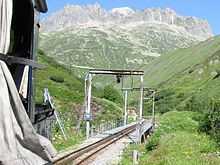Furka Summit Tunnel
 | |
| FO train at Muttbach-Belvédère portal, 1981. | |
| Overview | |
|---|---|
| Line |
Furka Oberalp Bahn (FO) (to 1981) Furka Cogwheel Steam Railway (DFB) (since 2000) |
| Location | Valais / Uri, Switzerland |
| Status | Open |
| Start |
Furka, Uri 46°34′34″N 8°25′42″E / 46.57611°N 8.42833°ECoordinates: 46°34′34″N 8°25′42″E / 46.57611°N 8.42833°E |
| End |
Muttbach-Belvédère, Valais 46°34′02″N 8°24′14″E / 46.56722°N 8.40389°E |
| Operation | |
| Opened | 3 July 1926 |
| Closed | 11 October 1981 |
| Reopened | 14 July 2000 |
| Owner | Furka Cogwheel Steam Railway |
| Operator | Furka Cogwheel Steam Railway |
| Traffic | Train |
| Character | Passenger |
| Technical | |
| Length | 1,874 m (6,148 ft) |
| Line length | 1,874 m (6,148 ft) |
| No. of tracks | Single track |
| Track gauge | 1,000 mm (3 ft 3 3⁄8 in) metre gauge |
| Electrified |
Overhead catenary, 11 kV AC 16 2/3 Hz (1942-1981) |
| Highest elevation |
2,160 m (7,090 ft) above the Sea |
The Furka Summit Tunnel (German: Furka-Scheiteltunnel) is a 1,874 metres (6,148 ft) long railway tunnel in southern Switzerland. It lies at an altitude of 2,160 metres (7,090 ft). The summit tunnel was completed in 1925, and first opened on 3 July 1926. It links the Furka railway station, in Uri, with the Muttbach-Belvédère halting point, in Valais.
Until 1982, when the summit tunnel was replaced by the Furka Base Tunnel, the railway line passing through the summit tunnel was part of the Furka Oberalp Bahn (FO). However, that line, which, along with the summit tunnel, was closed in 1981 and reopened in 2000, is now part of the Furka Cogwheel Steam Railway, a heritage railway operating in summer only.
Furka Oberalp Bahn (FO) operations
Between 1926 and 1981, the FO allocated three schedule periods to the line passing through the summit tunnel. The summer schedule corresponded with the then European summer timetable. The other seasons, covered by the then European winter timetable, were divided by the FO into autumn and winter periods, because traffic over the Furka Pass could be operated only until mid October.
As soon as snow started falling, the FO had to be ready to place individual items of rolling stock on either side of the Furka, according to demand. Then, during the years commencing with electrification of the line in 1942, the electrical contact wire had to be dismantled over a nearly 15 kilometres (9.3 mi) long section of line, and the line made "avalanche ready". Everything more than 1 metre (3 ft 3 in) above ground level had to be removed, necessitating a huge annual expenditure.

Some early onsets of winter brought distress to the FO. On those occasions, staff members had to clear the track. For that work, steam locomotives of type HG 3/4 were used until 1968. They were then replaced with modern diesel electric locomotives of class HGm 4/4. In the years when winter came early, locomotives and railcars sometimes had to be loaded onto standard gauge vehicles, to be transported from either Göschenen or Chur to Brig or vice versa, on the side of the pass where they were needed.

In 1963, the FO endured the most difficult of all its reopenings of the line. A team working with a steam locomotive on the snow front was hit and swept away by an avalanche. The incident cost several lives, including that of a journalist who had been compiling reportage about the snow removal. As a consequence of this incident, the construction of the Furka Base Tunnel was brought forward.
Closure and reopening
In 1982, the original portion of the FO between Oberwald in Valais and Realp in Uri, including the summit tunnel, was replaced by an FO line passing through the then new Furka Base Tunnel. The superseded portion of the FO line was abandoned. However, strong public protests against the removal of the abandoned tracks led to the foundation 2 years later[1] of the Furka Cogwheel Steam Railway (DFB), to preserve and operate the abandoned line.
Since 11 July 1992, the abandoned line has been progressively reopened from Realp, as a heritage railway operated by the DFB. On 14 July 2000, the DFB was extended from its then temporary terminus at Furka to Gletsch, via the Summit Tunnel, which was simultaneously reopened, and Muttbach-Belvédère.
See also
- Furka railway station
- Muttbach-Belvédère halting point
- Furka Base Tunnel
- Furka Oberalp Bahn
- Furka Cogwheel Steam Railway
References
- von Arx, Johannes (2000). Furka-Bergstrecke; Abenteuer Furka. Oberwald, Switzerland: Dampfbahn Furka-Bergstrecke. (German)
- Moser, Beat; Jossi, Urs (2007). MGB Matterhorn Gotthard Bahn 2. Fürstenfeldbruck, Germany: Eisenbahn-Journal (Verlagsgruppe Bahn GmbH). ISBN 978-3-89610-175-4. (German)
- Moser, Beat; Krebs, Peter (2010). Erlebnis Furka-Bergstrecke / Aventure Ligne sommitale de la Furka. Zürich: AS-Verlag. ISBN 978-3-909111-71-8. (German) (French)
- "Official timetable of Switzerland". Bundesamt für Verkehr. (English)
- ↑ 1.0 1.1 1.2 Bedding, James (12 March 2013). "Underground success: inside the world's longest tunnel". The Sydney Morning Herald: Traveller. Fairfax Media, Sydney. Retrieved 12 March 2013.
External links
- Furka Cogwheel Steam Railway (English)
- Matterhorn Gotthard Bahn (successor to the FO) (German)